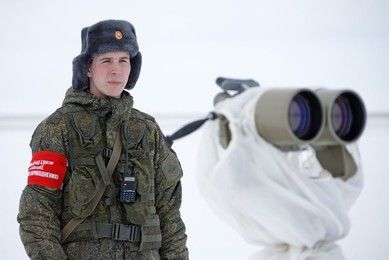Russia’s Arctic Policy

Russia has a dominant position in the Arctic relative to the other northern coastal states—the U.S., Canada, Norway, and Denmark. The former has more than half of the Arctic Ocean coastline and the largest fleet of icebreakers (40), necessary for navigation in this icy region, including nuclear-powered units. The permanent Arctic sea ice has been melting as the climate changes, which increases the area for navigation along the Russian coast, but this has raised concerns in Russia about i.e. the security of the state’s maritime border, among other worries.
Goals
In a document on Arctic policy until 2035, adopted in May, Russia set the priority as maintaining sovereignty and territorial integrity. Unlike earlier related documents from 2008 and 2015, Russia now perceives the Arctic as a place of international rivalry, resulting from, among others, U.S. Arctic policy.
Russia is seeking to establish preferential international legal regulations regarding the Arctic. It believes that the final status (the region is not fully regulated by an international agreement) should be settled only between the coastal states. To this end, it is active in the Arctic Council (AC), which includes Finland, Sweden, and Iceland. The current compromise between coastal states concerns the use of the Arctic Ocean based on the UN Convention on the Law of the Sea. Under it, they have the right to 200 nautical miles for an exclusive economic zone. Russia aims to increase this and has twice (in 2001 and 2015) submitted a request to the Commission on the Limits of the Continental Shelf, claiming new areas.
Russia wants economic development in its part of the Arctic. The document underlines the significance of the NSR, the shipping route from the Barents Sea to the Bering Sea. Use of this route is expected to contribute to increased investment in the Russian Arctic, particularly by Asian countries (mainly China), for which it shortens the distance to Europe by 40% compared to the sea route through the Suez Canal.
Economic Significance
The Arctic is a resource base for Russia and generates about 14-20% of its GDP. About 80% of Russian gas is extracted there, as well as nickel, diamonds, and rare earth minerals. Arctic resources account for one-quarter of the value of Russian exports. If Russia manages to enlarge its exclusive economic zone, it would gain access to new deposits estimated at 5 billion tonnes of oil and gas (current Russian oil reserves are about 14.5 billion tonnes).
Due to the resource potential of the Arctic, the Russian authorities are expanding infrastructure in this region. For example, the Russian company Novatek built the Yamal LNG terminal and plans to build another two more with the participation of Chinese, French, and Japanese companies. However, the pace of work is affected by the economic crisis caused by COVID-19. Because of this, some infrastructure projects will be postponed. The drop in oil prices that accompanied the pandemic has also led to the withdrawal of the British-Dutch Shell Company from the Arctic contract. The crisis in the energy industry may increase the difficulties in implementing the Vostok Oil investment plan, a project by state-owned company Rosneft, although it can count on additional support from the central budget. The project will connect, among others, oil fields in the north and provide the infrastructure needed to transport crude oil along the NSR. The Russian mining sector is also struggling with Western sanctions and restrictions resulting from access to advanced technology necessary for the exploitation of deposits in geologically difficult and climate-challenged Arctic areas (e.g., Exxon Mobil withdrew from work on the shelf). Although Russia benefits from China’s financial support in the Arctic as part of the Silk Road Fund and others, it is trying to balance the Chinese capital with investments from India, Japan, and South Korea. From Russia’s point of view, the Chinese concept of a Polar Silk Road, including promoting freedom of navigation in the Arctic, may pose a long-term challenge to Russia’s interests in the region.
The Russian authorities hope that greater use of the NSR for shipping will improve the economic and social situation in the north of the country. The transport of goods on the NSR is growing every year, from 2.8 million tonnes in 2013 to 31.5 million tonnes in 2019—it is expected to reach 80 million tonnes by 2024. So far, however, the route has been used mainly by Russian companies and only 1.3% of the transits in 2017 was international. This is because of Russia’s desire to limit free navigation along the NSR by requiring ships to be accompanied by Russian icebreakers. According to Russian regulations, gas and oil can be transported only by tankers under the Russian flag.
Military Significance
Russia’s increasing militarisation of the Arctic serves to strengthen the protection of Russian airspace and the potential for nuclear deterrence but also its capacity to conduct offensive operations. From 2014, as part of what it calls Arctic Shield, Russia opened six new military bases in the region and reactivated 14 airbases not used since the Soviet era. They are equipped with advanced S-300 and S-400 air defence systems. The installations also have short-, medium-, and long-range missiles and radar stations that cover the territories of NATO countries on its Northern Flank (U.S., Canada, Norway, Denmark). Russia has additionally invested in drones to help with navigation and coastal surveillance. Russian Su-24 and Su-34 bombers regularly violate the airspace of Arctic states, testing the reactions of NATO countries.
The Arctic is gaining importance in Russian defence planning. The Russian authorities are separating the Northern Fleet Joint Strategic Command near Finland and in January 2021 will transform it into an independent military unit with the status of a military district. The Northern Fleet has 40 warships (including one aircraft carrier) and more than 40 submarines. Some of the ships carry ballistic missiles with nuclear warheads, constituting a significant part of Russia’s nuclear deterrence potential. However, for budget reasons, all Russian Arctic projects, including new bases, have a dual military-civil function. Their staff is also mixed, including military brigades and Coast Guard units, equipped with advanced equipment and adapted to extreme polar conditions.
Conclusions and Perspectives
Russia is concerned with losing its special position in the Arctic to the U.S., Canada, or China. It will strengthen its military presence in the region to control its resources and maintain defence capabilities. The further militarisation of the Arctic is a challenge for NATO countries, as well as for Sweden and Finland, which will continue to experience violations of their airspace. The Alliance’s likely increased focus on the Arctic should not come at the expense of the Eastern Flank, due to the complementarity of challenges generated by Russia.
In 2021, Russia will assume the two-year presidency of the Arctic Council. It probably will try to block initiatives aiming for a greater opening of the Arctic to countries outside the region (including China). In this regard, it can count on Canada, which has a similar position on control of the Northwest Passage, as well as the U.S., which seek to deny Chinese expansion into the Arctic.
Russia’s desire to control shipping in the Arctic and the restrictions on the involvement of foreign investors in the mining sector in the region (e.g., share limits) contradicts attempts to make the NSR more attractive to foreign partners. In the long term, if Russian policy changes and infrastructure is expanded, the route can become an important international shipping lane. However, problems resulting from the COVID-19 pandemic and falling oil prices will likely delay the implementation of infrastructure projects and may stall new investments.


